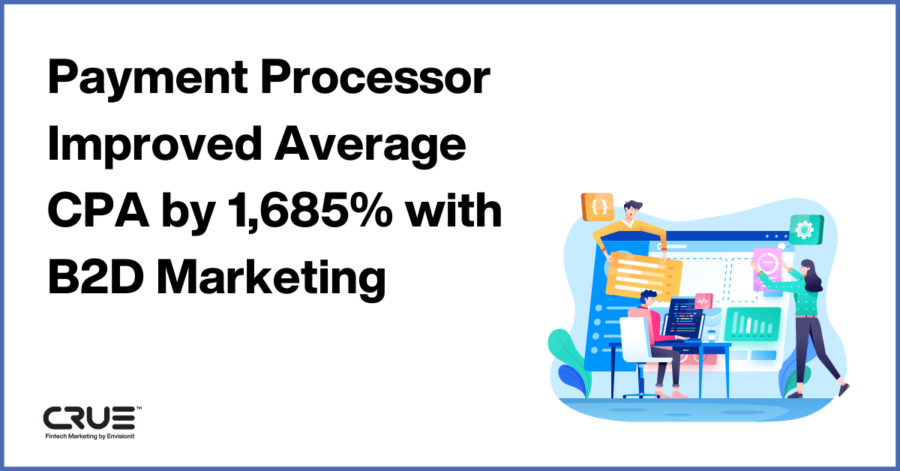The fintech industry is one of the most competitive in the world. With so many different companies vying for attention, it can be difficult for fintech brands to stand out from the crowd. As a digital marketing agency, we don’t discredit the “shot in the arm” paid media provides brands in terms of visibility, demand and lead generation. But do you know what’s equally as important, especially paired with your paid media efforts? Leveraging best-in-class SEO and content marketing to attract and convert more qualified customers.
In this article, we will discuss six ways fintech brands can use SEO and content marketing to stand out from (and outperform) competitors while attracting more customers by focusing on:
- Intent-based content marketing
- Smart keyword research
- Customer feedback
- Google’s E-E-A-T content quality guidelines
- Technical SEO
- Website user experience
Before we dig in, let’s level set on how we’re defining the basics of SEO and content marketing. While it seems straightforward, there is nuance and not everyone views marketing activities in the same way.
What is SEO?
SEO, or search engine optimization, is the process of improving the visibility of a website in search engine results pages (SERPs) by taking advantage of every touchpoint in the landscape. By optimizing websites with high quality content, an engaging user experience, and a strong technical infrastructure, fintech brands can make it more likely that their websites will appear higher in SERPs when users search for those keywords. This can lead to increased traffic to their websites, which can then be converted into leads and sales through strong website messaging and user experience (more on that later). An effective SEO strategy is one that meets the needs of both search engines and users alike – it’s about intentionally choosing your focus areas to take advantage of the rich search landscape that your brand operates within.
What is content marketing?
Content marketing is the process of creating and distributing valuable, relevant, and consistent content that attracts and speaks to the needs of a defined audience — and, ultimately, to drive profitable action. By creating high-quality content that is relevant to their target audience, fintech brands can build relationships with potential customers and position themselves as experts in their field. This can help build trust and credibility among the audience, which can eventually lead to converted customers and increased sales.
Keep reading to discover Envisionit’s tried and true SEO and content marketing strategies for fintech brands. If you’d like to discuss how these strategies can be applied to your fintech brand’s digital marketing efforts, get in touch.
6 proven SEO strategies to help your fintech brand succeed
Focus on intent-based content marketing
In order to set your fintech brand apart from your competition, it’s crucial that you focus on intent-based content marketing, or creating content that aligns with your customers’ needs, pain points, frustrations, key motivators and opportunities. By writing content that addresses these needs and pain points, fintech companies can position themselves as thought leaders and build trust with their customers.
To get started, we recommend identifying your customer profiles (or personas) and defining key characteristics for each. What motivates them? What are their day-to-day frustrations? What are their primary needs? What do they value most? What do they value least? Once you understand these things, you can start to develop content that will resonate with your audience.
This content can come in a variety of formats, whether it’s a blog post, video, white paper, ebook and so on. We recommend starting with a healthy mix of content formats so you can gather data on what seems to resonate best with your audience. If you’ve already invested in content marketing assets, take a look at what formats have performed well and prioritize those over others. The most important thing to keep in mind with content is that humans are visual – so whatever you create, be sure there is a visual element to it, incorporating charts, graphs, iconography, images to demonstrate your points.
Bonus points if you share this content on social media to expand reach to current and potential new customers.
Turn customer feedback into content assets
Create an ongoing process for gathering customer feedback so you can turn this valuable feedback into new angles for your content strategy. A few examples of questions to ask may include:
- What are the biggest challenges you face in your day-to-day work?
- What do you wish you had help or time for in your job?
- What frustrates you the most about your current technology or processes?
Another great way to obtain more direct customer feedback is your reviews. Take a look at industry forums, online review websites, Google reviews, and so on to see what your audience is saying about your solution. You’ll be surprised at how much of this feedback can directly influence your content marketing efforts.
Prioritize keyword intent over search volume
Once you have your content marketing assets built out, be sure to optimize this content with natural, relevant keywords. Don’t chase high search volume keywords just for the sake of ranking or driving traffic. In most cases, these keywords are already highly competitive, but most importantly, they likely won’t drive the qualified traffic that you are looking for. For example, instead of obsessing over ranking for a keyword like, payment processing, try to rank for a longer tail, more specific keyword like, integrated payment processing solution. Adding keyword modifiers like this will help your brand messaging stand out among competitors and allows you to demonstrate value in your solutions right away.
When it comes to ideal keyword placement for content optimization, we recommend inserting your primary and secondary SEO keywords in the following key on-page elements:
- Page title and meta description
- H1s and supporting headers (h2s, h3s, etc.)
- Introduction
- Body copy (naturally)
Pay close attention to Google’s E-E-A-T content quality guidelines
Ensure your content meets Google’s E-E-A-T content guidelines. Google’s E-E-A-T content guidelines stand for Experience, Expertise, Authority and Trustworthiness and state how content quality is evaluated and ranked on Google’s search engine results pages (SERP). It’s crucial that your content is written and reviewed by real experts in your field. E-E-A-T is even more important within the fintech landscape due to the financial nature of the topics, so we recommend learning more about E-E-A-T and incorporating these guidelines into your own content and SEO strategy.
A few ways you can demonstrate E-E-A-T in your content marketing is:
- Make sure your content writers are true subject matter experts in the field.
- Add author bylines that highlight the content creator and their expertise. This allows Google to understand the actual content creators themselves, plus, it creates a stronger user experience by building more trust and transparency in your content.
- Promote your content across LinkedIn and other relevant social media channels. Also, encourage your subject matter experts to be active on relevant social media channels.
- Use credible sources and externally link to other research or websites that you use to back up your content. Even better if your brand can conduct and publish your own research!
- Launch a strong backlinking strategy to promote off-page brand awareness and drive links back to your content marketing assets. If you’re interested in how Envisionit can help build high quality backlinks to your fintech website, contact us.
Ensure technical SEO is strong
Technical SEO is important for B2B fintech brands because it helps to ensure that your website is crawlable and indexable by search engines. A strong technical SEO strategy makes your website more likely to appear in search results, which can lead to increased traffic and conversions. You can create all of the content in the world, but if your technical SEO isn’t up to standard, Google will have a hard time finding and ranking this content.
Our SEO team conducts ongoing site technical audits where we focus on things like:
- Website structure
- SEO meta data
- Optimized body copy
- Internal and external linking
- Indexability and crawlability
- Page Speed and Core Web Vitals
- Mobile-friendliness and mobile experience
Bonus tip: Be sure to have a development team or development resources available for ongoing site maintenance and implementation of opportunities identified by the SEO team. The quicker you can implement optimizations to your website, the quicker you will reap the reward.
Create an effective website user experience
User experience (UX) refers to the overall experience that a user has when interacting with a website or digital product. Creating an effective and clear user experience is another way to set your fintech brand apart in the sea of sameness. We recommend implementing heat mapping to understand how your specific audience interacts with your website – then use this behavioral data to make informed decisions for site changes and optimizations. In addition to heatmaps, analytics data and user research should also inform your website’s user experience.
Our SEO experts have shared a few thought starters on how to strengthen the user experience across your fintech brand website, including:
- Calls-to-action: Be consistent and direct with the calls-to-action across your website. Ensure you have an optimized lead page that highlights value propositions, unique selling points and reiterates how your solution will solve your customers key frustrations. Be sure the form on your lead page is simple and easy to fill out on both desktop and mobile devices.
- Value propositions: Include clear “reasons to believe” on each key page. This may be in the form of a customer quote and testimonial, client logo wall, customer video testimonial, short case study statistics, etc. Be sure to incorporate this type of content on the homepage and key solution and product pages to help build customer trust, engagement and conversions.
- Navigation: Most of the fintechs with best-in-class user experience (think Stripe) take a minimalistic approach to their website navigation. Remember to use clear and concise labeling, prioritize your pages based on your sitemap, limit the number of items so you don’t overwhelm your visitors. The goal is to make it as easy as possible for your users to find what they are looking for.
Interested in learning more about these fintech SEO strategies, or want to hear how Envisionit can help your fintech brand acquire more qualified customers? Let’s chat.












